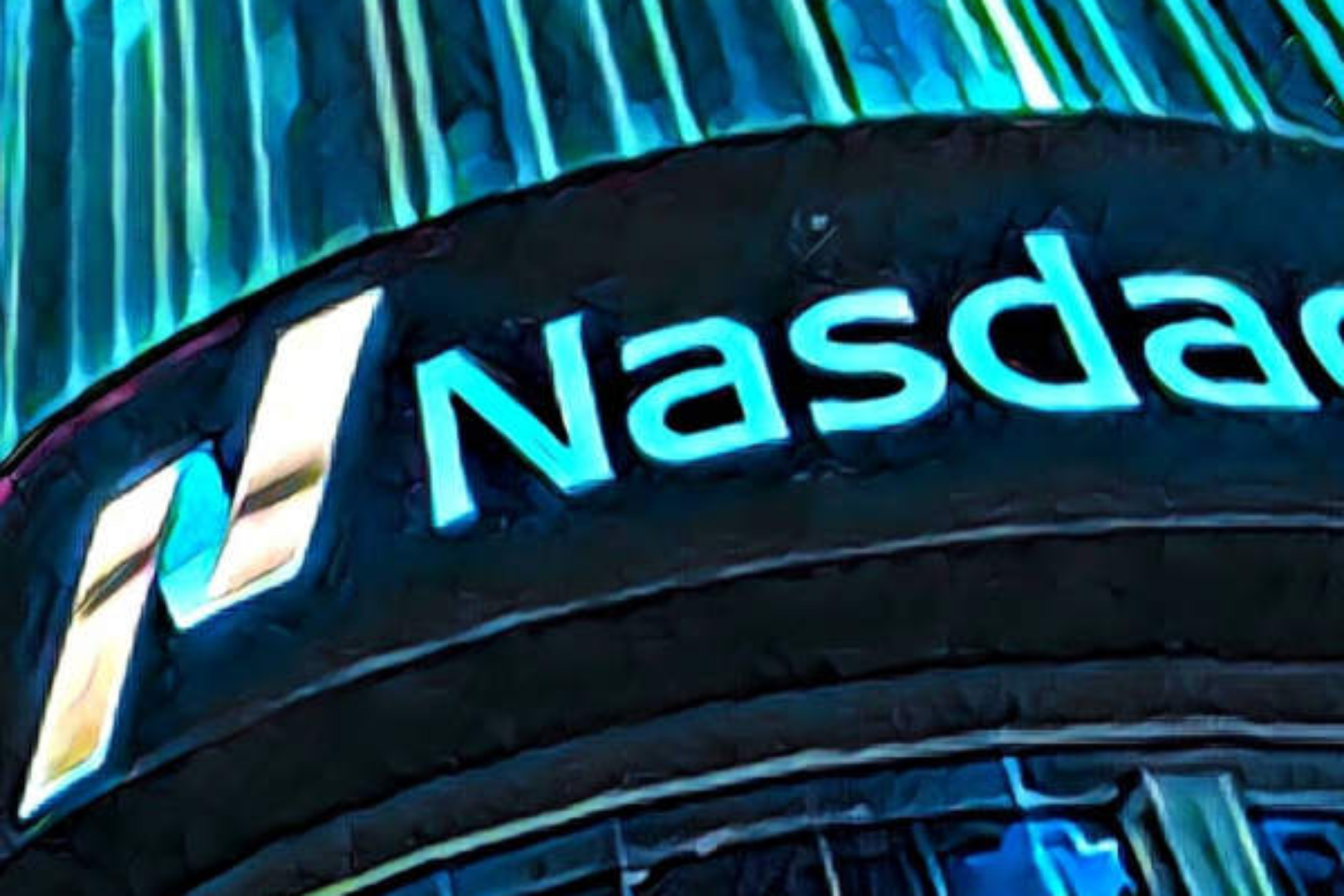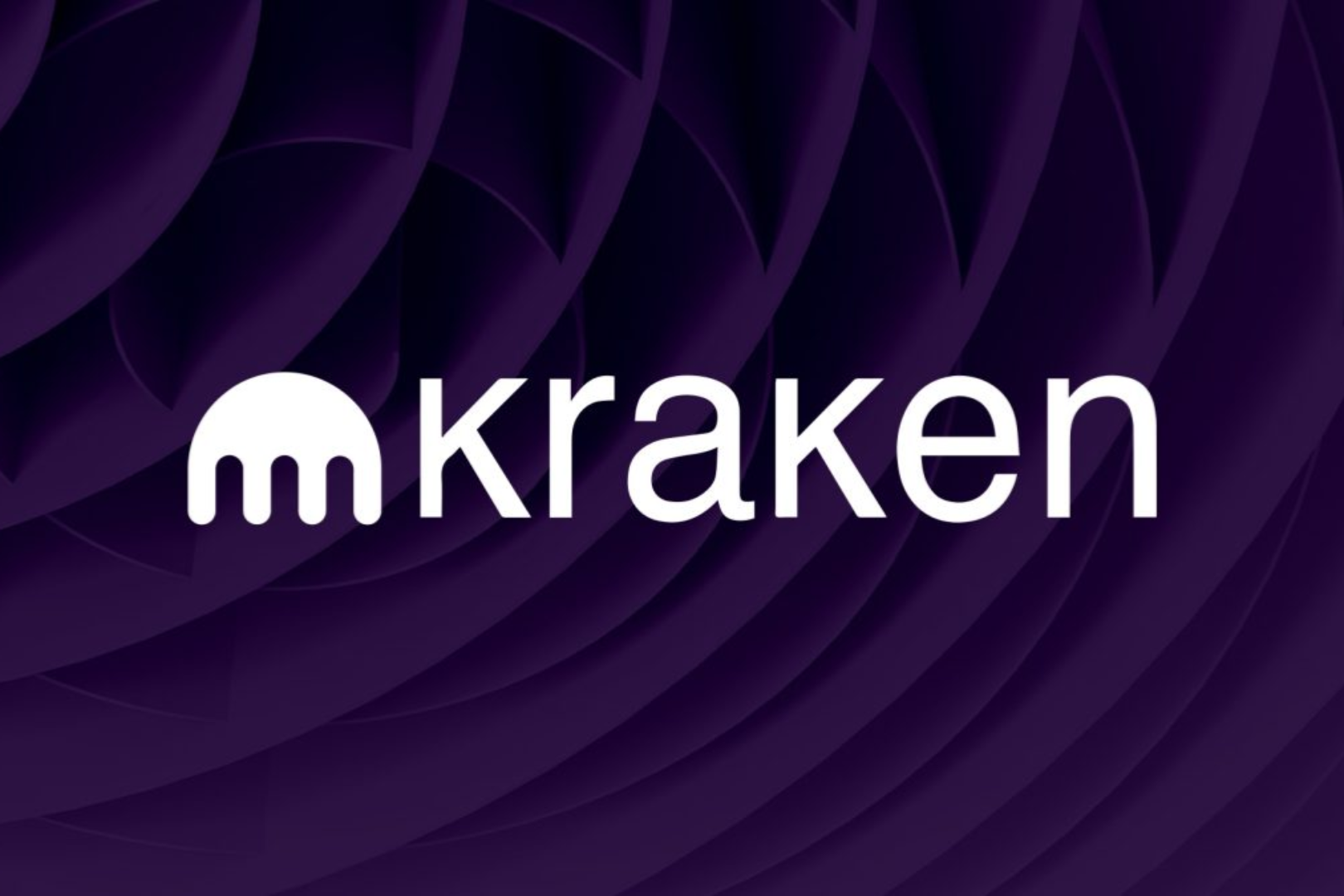
Original title: "Which crypto exchanges are about to be listed on the US stock market, and what are their valuations?"
Original article by Tanay Ved and Victor Ramirez, Coin Metrics
Original translation: AididiaoJP, Foresight News
Key Takeaways:
- Kraken, Gemini, and Bullish are planning initial public offerings (IPOs) amid a favorable regulatory environment and clear investor appetite for public market crypto asset exposure.
- Coinbase’s 2021 IPO set a benchmark for the industry. At its IPO valuation of $65 billion, Coinbase generated 96% of its revenue from transaction fees, while subscription and service revenue now account for 44% by the second quarter of 2025.
- Among IPO candidate exchanges, Coinbase still leads with 49% of spot trading volume. Bullish and Kraken each account for 22% and are rapidly expanding new services.
- Not all reported trading volume is equal. Round-trip transaction analysis reveals inflated activity on some platforms and highlights the need to assess the quality and transparency of exchanges.
introduction
For much of the cryptocurrency industry's history, the U.S. government has been cool, even hostile, to the industry. But last week, things took a positive turn.
The Presidential Task Force on Digital Assets released a 166-page report outlining the current state of digital assets and proposing policy recommendations for building a comprehensive market structure. Meanwhile, U.S. Securities and Exchange Commission (SEC) Chairman Paul Atkins announced the "Crypto Project" in a public speech, aiming to make the United States the "global crypto capital" by bringing financial markets online, streamlining the cumbersome licensing system for cryptocurrency businesses, and supporting the creation of financial "super apps" offering a variety of services.
The primary beneficiaries of this new regulatory framework are centralized exchanges. Several private centralized exchanges, such as Kraken, Bullish, and Gemini, are capitalizing on this relatively favorable environment to pursue initial public offerings (IPOs). As these companies open up to public investment, it's crucial for investors to understand their fundamental drivers. In this article, we will delve into the key metrics of these exchanges and highlight some caveats when using exchange-reported data.
Cryptocurrency exchange IPO boom
Since Coinbase's IPO in April 2021, there have been few crypto-related IPOs in the past four years, largely due to the adversarial relationship between cryptocurrency companies and the former SEC. As a result, private companies were unable to access liquidity in public markets, and non-accredited investors were unable to profit from investing in these companies. With the Trump administration promising a friendlier regulatory regime, a new wave of private cryptocurrency companies announced plans to go public.
This environment, coupled with renewed investor interest in public market crypto exposure, has spawned some of the most explosive IPOs, such as Circle’s recent public offering. Gemini, Bullish, and Kraken are planning to go public in the U.S., hoping to capitalize on this opportunity and position themselves as full-stack service providers for digital assets.
Coinbase's 2021 IPO
Coinbase's 2021 IPO provides a useful benchmark for assessing the investment prospects of potential exchange IPOs. The company went public via a direct listing on Nasdaq on April 14, 2021, with a reference share price of $250 per share, resulting in a fully diluted valuation of $65 billion, and an opening price of $381. Coinbase's IPO coincided with the peak of the 2021 bull market, when the Bitcoin price approached $64,000 and exchange trading volume exceeded $10 billion.
According to its S-1 filing, Coinbase’s business model at the time was very simple, with the majority of its revenue coming from transaction fees:
"From our inception to December 31, 2020, we generated over $3.4 billion in total revenue, primarily from volume-based fees collected by retail users and institutions on our platform. As of December 31, 2020, trading revenue accounted for over 96% of our net revenue. We leveraged the strength of our trading business to expand and broaden our platform, launch new products and services through investment in flywheels, and expand our ecosystem."
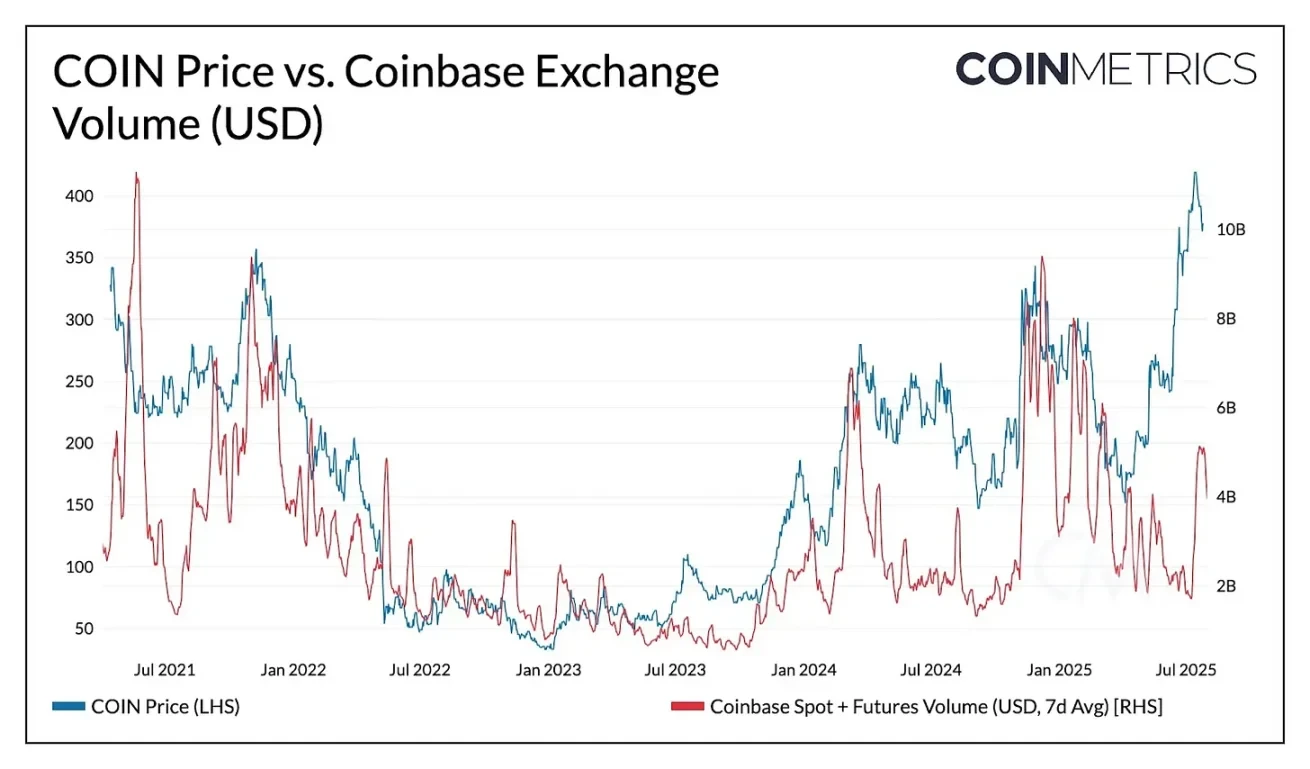
Source: Coin Metrics Market Data Pro and Google Finance
Today, Coinbase is more like a "full-stack exchange." While trading remains its core business, its business model has significantly expanded to encompass a full stack of cryptocurrency services. This change is beginning to manifest itself in the relationship between COIN price and trading volume. While the two were closely correlated in the early days, this correlation has weakened with the increasing importance of "subscription and service revenue" (including stablecoin revenue (USDC interest income), blockchain rewards (staking), and custody revenue).
Coinbase Q1 2021:
- Revenue of $1.6 billion
- Trading revenue: $1.55 billion (96%)
- Subscription and services revenue $56 million (4%)
Coinbase Q2 2025:
- Revenue of $1.5 billion
- Trading revenue $764 million (51%)
- Subscription and services revenue $656 million (44%)
- Corporate interest income of $77 million (5%)
Comparative Analysis of Upcoming IPO Exchanges
Based on this framework, we present estimates of valuations, trading volumes, and business sectors for exchanges with upcoming IPOs.
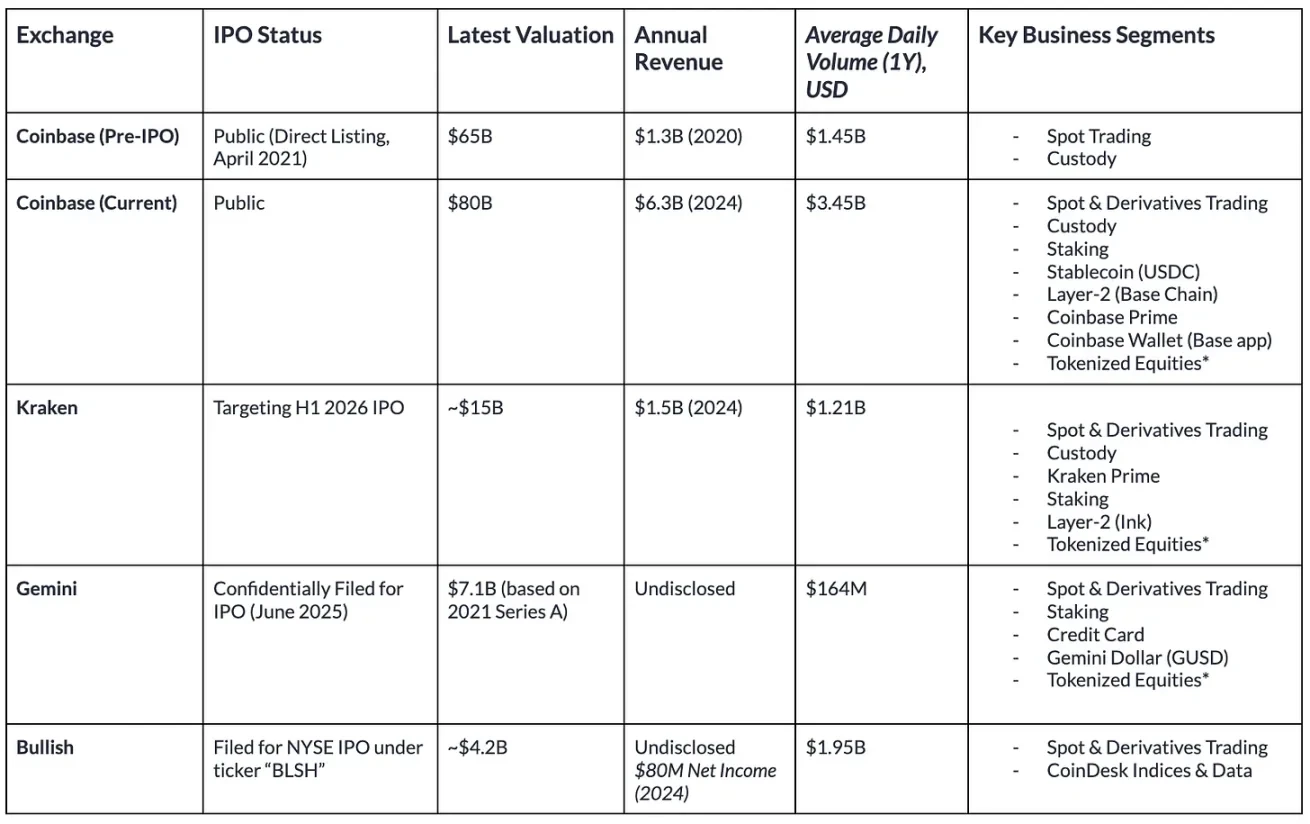
Source: Coin Metrics Market Data Professional and public company filings (data as of August 1, 2025)
While the services offered by these exchanges converge, they differ significantly in their market influence and the scale of their trading activity.
Founded in 2013, Kraken has reached a more mature stage. The company boasts strong financial growth, projecting $1.5 billion in revenue in 2024 (a 128% increase from 2023) and $412 million in revenue in the second quarter of 2025. Kraken has also acquired NinjaTrader, secured the European MiCA license, and strategically expanded into areas such as tokenized stocks, payments, and on-chain infrastructure (Ink). With a target valuation of approximately $15 billion and $1.5 billion in revenue in 2024, its revenue multiple is 10x, slightly lower than Coinbase's 12.7x.
In comparison, Gemini is smaller. Its average trading volume over the past year was $164 million, the lowest among these exchanges. Gemini's most recent valuation dates back to its $7.1 billion Series A funding round in 2021, with private market valuations pegged at $8 billion. In addition to spot and derivatives trading, Gemini offers staking and credit card products, providing yield on user deposits. It is also the issuer of the Gemini Dollar (GUSD), though its circulating supply has fallen to $54 million.
Bullish ranks among the top in trading activity, with an average trading volume of $1.95 billion over the past year. Bullish Exchange, the core of its trading and liquidity infrastructure, is focused on institutional clients and is regulated in Germany, Hong Kong, and Gibraltar, while actively pursuing a US license. Bullish has also expanded into information services through the acquisition of CoinDesk. According to its F-1 filing, the company projects a net profit of $80 million and a net loss of $349 million in 2024. Based on a SPAC transaction canceled in 2022, its initial valuation was close to $9 billion, and it is currently reportedly seeking a valuation of $4.2 billion.
Exchange volume trends

Source: Coin Metrics Market Data Pro
Overall, Coinbase and other exchanges with upcoming IPOs account for only approximately 11.6% of the reported spot trading volume on centralized exchanges. Binance alone accounts for 39%, while other offshore exchanges also have significant shares. Among the exchanges in focus, Coinbase accounts for 49% of spot trading volume, while Bullish and Kraken each account for 22%. Since its launch in 2022, Bullish's share has steadily increased, while Kraken's has shrunk as competition has intensified.
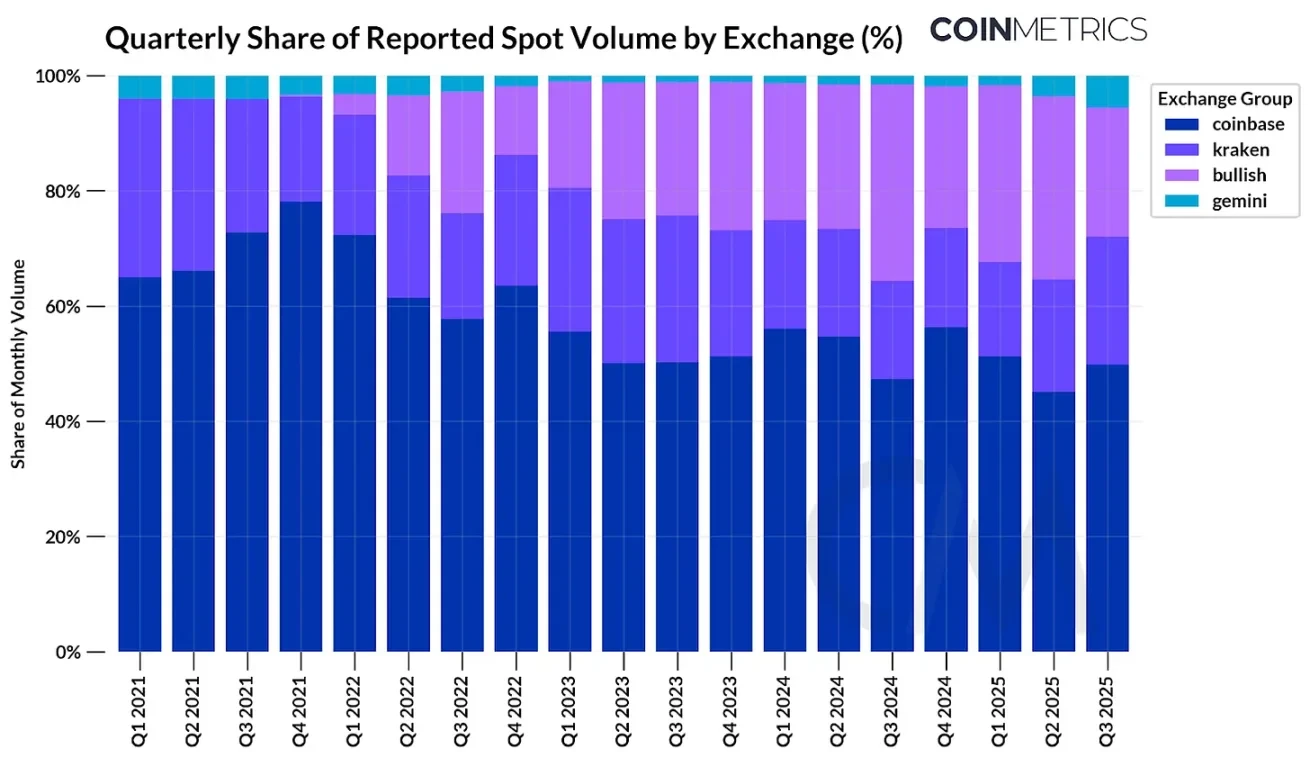
Trading on the Order Book: Analyzing Economic Activity on Exchanges
As mentioned above, trading volume is one of the most predictive metrics for estimating valuation. However, reported trading volume can vary across exchanges, making it a misleading data point.
While most major cryptocurrency exchanges have cracked down on wash trading, some irregularities still exist. Our Trusted Exchange Framework methodology details how to detect unusual trading activity and assesses qualitative factors such as regulatory compliance.
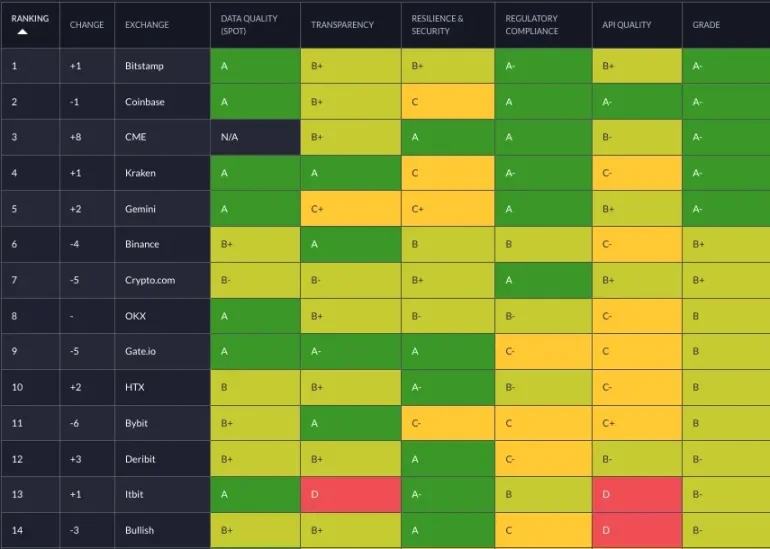
Source: Trusted Exchange Framework
A more powerful signal we developed to detect buy and sell trades is to calculate the frequency of repeated trades. Our testing method is as follows:
- We randomly sampled 144 5-minute periods from January to June 2025, generating nearly 20 million transactions.
- For each exchange and session, select one trade.
- If there is another transaction within 10 transactions or 5 seconds with the opposite direction, amount and price being almost the same (<1%), then the two transactions are marked as duplicate transactions.
- Repeat this for each transaction. If a transaction has already been marked as a duplicate, skip it.
- Calculate the volume of transactions marked as duplicates and divide by the total volume.
In the figure below, we plot a sample of transactions from a few exchanges over a period of time and mark suspected round-trip transactions. Each gray dot represents a normal transaction, while the green and red markers represent round-trip transactions.

Source: Trusted Exchange Framework
Due to the approximate nature of this methodology, we expect some false positives due to duplicate trades caused by normal market activity (e.g., market makers facilitating trades by providing liquidity on both sides of the order book). However, the high percentage of duplicate trades compared to industry baselines such as Crypto.com and Poloniex raises concerns about the reliability of their reported trading volume data.
For example, we estimate that Crypto.com's trading volume for BTC-USD ($201 billion), BTC-USDT ($192 billion), ETH-USD ($165 billion), and ETH-USDT ($160 billion) was approximately $720 billion in Q1-Q2 2025. Based on these estimated proportions, approximately $160 billion of these pairs' volume came from repeat trades.
in conclusion
With several cryptocurrency exchanges poised to go public, it's crucial for investors to understand the relative trading volumes of these platforms. While trading volume helps estimate trading revenue (which still accounts for the majority of revenue), qualitative factors such as business diversification, the presence of repeat transactions, and regulatory compliance are also crucial in assessing an exchange's quality. This information can help market participants determine whether valuations are justified.
Coinbase remains a leader four years after its IPO, primarily due to its diversified revenue streams across custody, stablecoins, and Layer-2 fees. However, competition in the exchange market is intensifying. To compete, other exchanges must diversify their revenue streams beyond trading-related fees, which are highly dependent on market sentiment. As market structure becomes more defined, exchanges are being allowed to evolve from trading venues into full-fledged super-applications. How these exchanges seize this opportunity, and whether they can realize their vision and replicate the success of past breakthrough IPOs, will be key developments to watch in the coming year.



